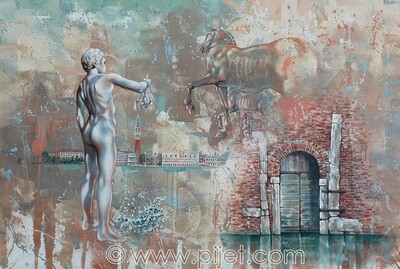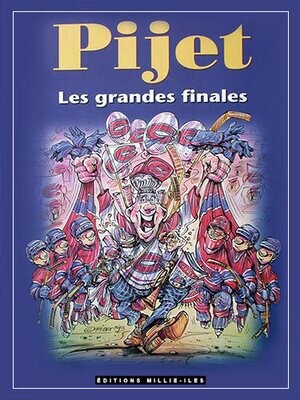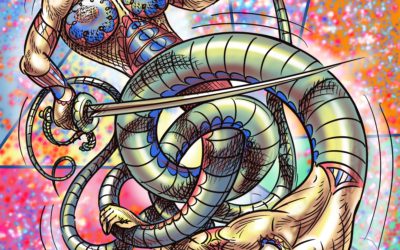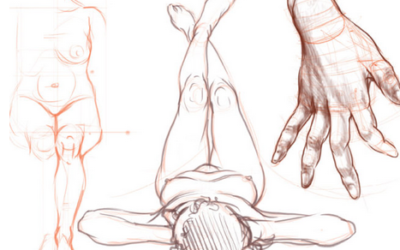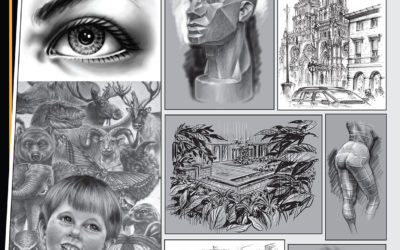Symbolism and composition in Bellini’s votive portraiture.
Giovanni Bellini’s Madonna of the Red Cherubs (see fig.1) stays apart from all his other votive portraitures of Virgin and Child. The painting has a classical Bellini’s composition of his half-length Madonna’s, however what makes it particular, is the outstanding presence of Red Cherubs in the background, used only once in his entire collection of votive portraits. The Madonna of the Red Cherubs in comparison with two others Bellini’s votive paintings shows different symbolic approach to the theme of Madonna and Child.
There is little information available about the exact time and conditions concerning the commission of the painting Madonna of the Red Cherubs by the Scuola di Santa Maria della Carità to Giovanni Bellini. What is less or more known that this artwork was executed sometimes between 1480 and 1490. According to different scholars several dates are proposed, based on their research.[1] The present location of Madonna of the Red Cherubs is in the Gallerie dell Accademia, in Venice.
The painting was commissioned to Bellini by Scuola Grande di Santa Maria della Carità. The first Scuola Grande in Venice, established in 1260 as Scuola Grande dei Battuti. The first meetings of the members were conducted in the church of San Leonardo. In 1294, they obtained their own hall. Starting from 1345, the Scuola went through few significant architectural extended changes.[2] The latest were executed in eighteenth century, since than it had become a part of The Gallerie dell’Accademia. The Scuola’s principal activities were to take care of the sestier Dorsoduro, where they were located. The Scuola had a charitable and devotional character, providing the moral and spiritual support to those in need, supplying affordable housing, clothing, food, money, dowries to the young girls. gifts, taking care about sick and dying.
The Madonna of the Red Cherubs represents a very common subject of Renaissance Italy votive paintings, which was The Virgin Mary with Child Jesus. The cult of Madonna and Child spread trough Renaissance Venice, and artists were competing with their creativity to depict her image in many different ways. Giovanni Bellini approached this subject in his own particular to him style. In the composition of Madonna of the Red Cherubs, he used, as in most of his half-length Madonna’s[3] paintings, the form based on the Byzantine heritage of votive icons,[4] which origins came from antiquity.[5] In The Madonna of the Red Cherubs, Bellini placed the Red Cherubs[6], floating on the clouds over the Virgin and Child heads.
The use of Red Cherubs in arrangement makes this painting outstanding from all other his Madonna’s works. The Red Cherubs signify passionate eternal love in meaning, but in composition it provokes us to look at the sky, which is symbolizing The God’s Kingdom. It also makes us understand that we, as worshipers, have the possibility of the direct contact with God through the Virgin Mary and Child Jesus. The background landscape, innovatory approach particular to Bellini Madonna’s, most the time symbolizes the world we live in, connected by the horizon with the sky, as direct correlation between our present and the future life, waiting for everyone after the Last judgment.
In the first plan we have an image of Mary in three quarter pose looking warmly and lost in thoughts at the Child Jesus, who seems to be spellbound by the Red Cherubs drifting on the clouds over his head. Jesus, in his three quarter placement, seems to gaze at his mother at the same time as at the busy sky. Madonna’s hands are embracing the Child’s body in protective way. Mary’s contemplative regard at Child Jesus suggests her worries concerning her child’s future as the saver of a human kind by sacrificing his own life. Placing the Red Cherubs in the composition, Bellini deepened the background landscape. By doing so, he emphasizes Mary and Child presence, and by pulling part of her tunic further in front, on the parapet, he completed the impression of a three dimensional space in the painting.
Bellini, as all artists of the Renaissance, was using in his work symbolism in order to fulfill the characteristic of depicted personages. In all his half-length portraiture, he is proposing chromatic narration. The color tells a story. In Madonna of the Red Cherubs Mary has a blue-greenish tunic:[7] the blue symbolizes the divinity, God’s Kingdom, devoutness, and infinity; the green is a symbol of nature, life, fertility, resurrection, and virtues. Bellini is using the chromatic symbolism to instruct us about Mary’s life and her outstanding qualities. Further more, he is telling her story. Madonna’s head is covered with white scarf: signifying virginity, excellence, spirituality, holiness, and the eternity of life. The blue-greenish tunic overlies the white scarf. Mary’s red clothing illustrates the human flesh, energy, love, sacrifice, and resurrection of Jesus Christ.
Bellini refers to the future events, regarding Mary and her Child. The color of Jesus garment is white, underlining his divinity, innocence, indicating his unawareness about incoming events.
The entire composition has an indicator of the existing separation between the holiness of depicted figures of Mother and Child, and the mortal world of the worshiper. Dividing the space between them by the parapet,[8] Bellini underlined the detachment between the secular and the divine. In the case of Bellini’s votive portraits of Mary and Child Jesus, the parapet plays a role of the border along which two realities, the holy and secular are meting together. The Madonna’s tunic is overlapping slightly towards the worshipper intimate space. Suggesting the particularity of the relationship between the divine and the mortal. All the draperies are perfectly modeled with the soft transition of colors from dark to light.
The painting marks a period of extreme virtuosity of Bellini’s brush and color. Each detail is meticulously depicted. In the landscape behind we can distinguish every tree and building in the composition. Looking at this image with such details, we see a work of an artist in full control of the medium he was working with.
In the other two paintings we can observe how Bellini approached the same theme of Madonna and Child, using completely different elements in the composition, in order to create various ambiances.
The first painting, Madonna and Child, known as The Rogers Madonna (see fig.2), has similar composition, created approximately in 1485 and 1490, which recent location is in Metropolitan Museum of Art in New York. The second is The Sacred Conversation, also known as The Madonna and Child with Two Female Saints (see fig.3), executed around 1490, from the Venier collection, recently located in The Gallery of Academia in Venice.
The Rogers Madonna, in comparison to The Madonna of the Red Cherubs, represents different approach to the subject. Bellini rearranged the composition in different way. The red curtain behind Mary and Child, covering the most of the city landscape and mountains, making both of them closer and intimate to the viewer, replaces the Red Cherubs. We can sense the presence of the holy Mary and Child in the room. In this case the symbolism of red curtain refers us to sanctification, penance, renunciation of the earthy delights, and as such to the Jesus sacrifice, made in order to save ours souls. It also separates the holy from the landscape behind, emphasizing the importance of portray figures.
The colors on The Rogers Madonna are deep blue for tunic with gold stripe around symbolizing divinity, spiritual enlightenment, and clear red for Mary’s cloth. Her head is covered with white scarf. Mary’s regard is not contemplative, as in Madonna of the Red Cherubs, in contrary, she is looking at the viewer, with a dose of accusation in her eyes, as she wants us to realize that she is going to loose her son, because of our sins. It looks like as she’s saying, “look how beautiful he is, and he is going to die, because of you”. There is something in the way she looks at us, which obstructs the harmony of this painting. In the previous work, the harmony of the scene is peaceful, and in The Rogers Madonna, Mary looks little agitated by the necessity to accept the outcome.
The naked Child Jesus, holds in his hand a quince (symbol of resurrection) with eyes directed to the heaven. He’s embraced in similar protective way of Mary’s hands. Child nakedness is symbolizing many things, but mostly sincerity, purity, truth, simplicity, and innocence. Each element of the painting has a narrative role to play. All together it makes perfect sense. If we concentrate little more on the landscape behind, first we see empty fields with naked trees, represented us. When we are born, we are naked, and as the days go by, we get on a road to knowledge, which is symbolized by the foliated tree. Going further, we establish ourselves in the society, we marry, we have children, and we live our adult existence, represented by buildings, which symbolize household, security, and family. As we advanced in age, we are approaching mountains, which are symbolizing purgatory, king’s heaven, unification with God, and a place of happy eternal rest. Than, we end our earthy existence by dying. Our soul makes a voyage to the clouds, to the world of heaven.
In Bellini’s paintings, each element has a meaning, and in order to read more from his work, than just admire his technical skills, it is necessary to posses a minimum knowledge about symbolic references of that time.
In most of his half-length Madonna’s, the landscape has similar meanings, and it doesn’t serve just to balance the composition. What it does however, when dividing the viewer by the parapet, it creates a three dimensional space, a window, which separates a worshiper from the divinity, and heavens world. By living an honest life, spreading peace and love, respecting others and sharing our fortune with those in need, we will have a privilege to enter this world of peace and eternal happiness after death.
In The Madonna and Child with Two Female Saints, Bellini painted Mary with Child Jesus in company of two Saints, identified as, Saint Catherine, and Mary-Magdalene. Bellini depicted the Saints without their usual characteristic attributes, which in the case of Saint Catherine would be either crown, sword, palm, or wheel. For Saint Mary Magdalene, it would be scull, long hairs, and pot for unguent. However he used other elements and ideas in order to indicate the identity of Saints. Saint Catherine has pearls in her hairs, which symbolizes purity, delight, health, wealth, belief, and happiness in marriage; all of these refer to her virtues. Mary-Magdalene has a black garment, symbolizing immorality, wrongness, humility, and penance, overlaid with a red trapeze dress, decorated with jewelled collar composed from pearls and red stones. She is painted with free falling long curly hairs, symbolizing a woman of doubtful past.
Saint Catherine on the left, with her hands together deeply concentrated on her prayers, she is submitting herself to the will of God, to the will of Jesus. On the other site, Saint Mary-Magdalene look into infinity, and her regard is full of thoughts and regrets. Her hands are placed on her breast in the form of cross; we can feel she is concentrated on purification of her soul, on redemption. All personages emanate the warmness of their souls, creating an ideal atmosphere for prayers and meditation.
For the same category of votive half-length representation of Virgin and Child, Bellini used completely different approach in choosing composition and characters. In comparison to The Madonna of the Red Cherubs, The Madonna and Child with Two Female Saints has completely different atmosphere. Instead of painting Red Cherubs, Bellini chooses to Saints wearing red clothes, as a reference to the Jesus resurrection. The saints are placed on each side, forming the Angels wings. Mary and Child are in the center of the painting. Jesus naked is sitting on the white pillow, symbol of his virtues. In comparison to the two previous votive images, the Child Jesus eyes are directed to the heaven, only this time from the different angle. The chanting angels, or the light of Holy Spirit might absorb him. His mother, Madonna, looks at him with tension of worry about his future, while on the first painting with Red Cherubs she has more contemplative regard, and on the second painting with the red drapery she has accusing look. There is no landscape behind, just empty dark space, from which the holy figures appear. There is no parapet dividing us from the holly. Their features are shaped with light coming from the top front direction, like from heaven. It is the first time Bellini used a dark background, and one source of light for his half-length votive image. As suggested by Robertson, Bellini had probably a chance to see the work of Leonardo da Vinci, and his “sfumato,” what probably inspired him to imply it in his own way in The Madonna and Child with Two Female Saints,[9] with great success.
Bellini was able to create an atmosphere of spiritual dialogue and movement of souls in the motionless and static compositions. That’s what makes his work so pleasant to look at. He wasn’t the first to create a dark background[10] in order to emphasize the dramatic content. However, with his mastery of color sensibility each of those chosen works for comparison, is a masterpiece in it’s own way, all united with the same theme of Madonna and Child. They have their own, appropriate to them personalities with their own unique drama at that moment. Each masterpiece has distinctive votive purpose. They represent Bellini’s extraordinary sensibility of color, imagination and modeling of human futures. Each of these paintings is connected by Bellini’s compositional genie, serving as his artistic signature.
[1] Venturi (1907), Gronau (1930), proposed the execution date around 1490. which is supported by such scholars as: Longhi (1949), Gamba (1937), Dussler (1935 and 1949), Pallucchini (1949 and 1959), Heinemann (1962), and Pignatti (1969). Others, such as: Robertson (1968), and Goffen (1989) established the creation date between 1480 and 1485.
[2] The Guild was founded in 1260 as Scuola Grande dei Battuti, moved to present location in 1344, changing the name to Santa Maria della Carita, inspired by the neighborhood of church and monastery. In 1345, they acquire additional land, which permit to build bigger hall. In 1384 they obtain further concessions from the monastery. The reconstruction of the Carita Church permitted in 1443-44 another enlargement of their active space. In 1461 the Scuola received a new façade. It was decorated with sculpture and paintings during between the 1484 and 1534. The last modifications of the façade were maid in the eighteenth century. After the Napoleon’s edict of 1806, concerning a closing all religious institutions (Scuole) and churches, the Church of Santa Maria della Carita, Convento dei Canonici Lateranensi and Scuola Grande di Santa Maria della Carita, were united in one architectural complex (1807-1811 and 1830) of Academia di Belle Arti and Gallerie dell Accademia.
[3] According to Rona Goffen. Giovanni Bellini. Yale University, 1989, he painted over 80 compositions of Madonna’s, which we know about. There might be many others, which wasn’t documented. He may be considered as an artist, who painted the most of Madonna’s.
[4] The Virgin Hodegetria, which according to the existed legend was a portrait of Mary, painted by St-Luc, to whom Mary appears few times. The legend appear sometimes around 6th century, or even earlier.
[5] Half-length figures started in antiquity, particularly in Italian antiquity; where the death Rulers were depicted in order to preserve the memories of them. They had votive as well as protective, purposes already than.
[6] Referring to the text of Nicola Coldstream, Angel, Oxford University Press, 2006, usually the Cherubim had a blue color, and the Seraphim were red.
[7] In some reproductions her tunic is green and others, blue –greenish. In order to know the real color, one has to see the original work. I couldn’t find any information about it.
[8] The parapet was very characteristic to Bellini’s votive and secular portraits. There were some other painters using this kind of division between the spectator and the portrayed, but mostly among his followers like Titian and Giorgione.
[9] According to the new publication: Giovanna Nepri Scire, Augusto Gentili, Giandomenico Romanelli, and Philip Rylands, La painture dans les Musee de Venice, Magnus Edizioni SpA, Udine, Italy. Editions Menges, Paris, 2002, p.74, p. 78. The two figures representing Saint Catherine and Saint Mary-Magdalene are probably the two Venetian patricians, who commissioned the artwork.
Bibliography.
Anchise Tempestini, Giovanni Bellini, Editions Liana Levi for French translation of RCS Libri S.p.A., Milano, 1997, p. 215.
Anchise Tempestini. Giovanni Bellini. Electa, Milan, 2000. Gallimard, Paris, 2000, p. 122.
ARC, Art Renewal Center: http://www.artrenewal.org/asp/database/art.asp?aid=290
Art-Cyclopedia: http://www.artcyclopedia.com/artists/bellini_giovanni.html
Artur Symons, “Notes on Giovanni Bellini,” The Burlington Magazine for Connoisseurs, Vol. 37, No. 211. (Oct., 1920), p. 170+173-176.
Baron von Hadeln Detlev, “Bellini’s Madonna del Baldacchino,” The Burlington Magazine for Connoisseurs,” Vol.53, No. 309, (Dec., 1928), p.268+270-271+274- 276.
David Alan Brown, Sylvia Ferino-Pagden, with Jaynie Anderson, Deborah Howard, Peter Humfrey, and Mauro Lucco. Bellini-Girgione-Tytian and The Renaissance of Venetian painting. National Gallery of Art, Washington, 2006. www.nga.gov
Everard Meynell. Giovanni Bellini. London: George News Limited, Southampton Street, Strand WC. New York, Frederic Warne & CO. The Ballantyne Press, Tavistock Str. London.
Elisa De Halleux. Iconographie de la Renaissance Italienne. Flammarion, Paris, 2004.
Felton Gibbons, “New Evidence for the Birth Dates of Gentile and Giovanni Bellini,” The Art Biuletin, Vol.45, No. 1, (Mar., 1963), p. 54-58.
Giles Robertson, “Giovanni Bellini,” The Burlington Magazine, Vol. 92, No. 562, (Jan., 1950), p. 2526.
Giles Robertson. Giovanni Bellini. Oxfort at The Clarendon Press, 1968.
Giovanna Nepri Sciré, Augusto Gentili, Giandomenico Romanelli, and Philip Rylands, La Peinture dans les Musées de Venice, Magnus Edizioni SpA, Udine, Italy, Éditions Mengés, Paris, 2002, p. 74, p. 78.
http://en.wikipedia.org/wiki/Giovanni_Bellini
http://www.culture.gr/2/21/218/218ab/e218ab10.html
Les Classiques de l’Art. Tout l’oeuvre peint de Giovanni Bellini. Rizzoli Editore, Milano, 1969. Flammarion, Paris, 1875.
Mary Hollingsworth. Patronage in sixteenth-century Italy. John Murray Publishers Ltd., 1996.
Nicola Coldstream, Angel, Oxford University Press, 2006. Grove Art Online: www.groveart.com
Old and Sold, Antiques Digest: http://www.oldandsold.com/articles29/venice-17.shtml
Patricia Fortini Brown. The Renaissance in Venice. Calmann and King Ltd., London, 1997.
Paul Faure. La Renaissance. Presses Universitaires de France, 1949.
Peter Humfrey. The Cambridge companion to Giovanni Bellini. Cambridge University Press, 2004, p. 184.
Peter Humfrey. Painting in Renaissance Venice. Yale University Press, New Haven &London, 1995. R. E. F., “A Madonna and Child: By Giovanni Bellini,” The Metropolitan Museum of Art Biuletin, Vol. 3, No. 10, (Oct., 1908), p. 179-182.
Renaissance Personalities: http://www.yesnet.yk.ca/schools/projects/renaissance/index.shtml
R.Henniker-Heaton, “A Bellini Madonna.” The Burlington Magazine for Connoisseurs,” Vol. 61, No. 357, (Dec., 1932), p. 250-253.
Roger Fry, “Giovanni Bellini’s Madonna and Child,” The Burlington Magazine for Connoisseurs,” Vol. 47, No. 269, (Aug., 1925), p. 64-65.
Rona Goffen. Giovanni Bellini. Yale University, 1989, p. 51-52.
Rona Goffen, “Icon and Vision: Giovanni’s Bellini’s Half-Length Madonnas,” The Art Biuletin, Vol. 57, No. 4, (Dec., 1975), p.487-518.
Ronda Kasl. Giovanni Bellini and the Art of Devotion. Indianopolis Museum of Art, 2004.
Scuola Grande Di Santa Maria della Carita’: http://www.cheapvenice.com/scuola-grande-carita’.htm
Ministero per i Beni et le Attivita Culturali: http://www.artive.arti.beniculturali.it/
W. R. Valentiner, “A Madonna Drawing by Giovanni Bellini,” The Burlington Magazine for Connoisseurs,” Vol. 65, No. 380, (Nov., 1934), p. 237-239.
Web Gallery of Art: http://www.wga.hu/frames-e.html?/html/b/bellini/giovanni/1480-89/index.html

